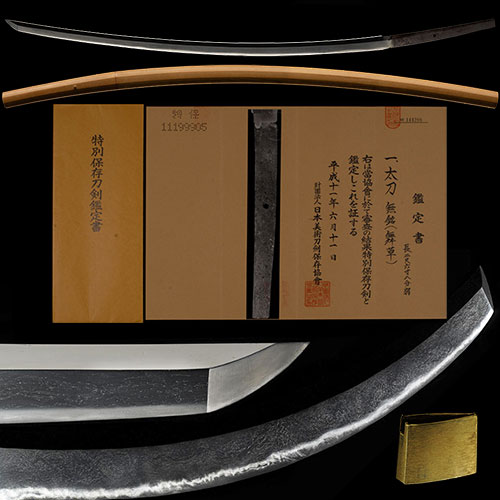
舞草 刀Mogusa Katana
No.537180舞草 平安後期900年前 重要候補 足 葉 金筋 砂流し頻りに掛かる二尺六寸八分Mogusa Late Heian period 900 years ago Juyo candidates Ashi and You Kinsuji and Sunagashi-shikirini-kakaru 81.2cm
ご成約Sold
- 極めKiwame
- 舞草Mogusa
- 登録証Registration
- 岩手県 Iwate 昭和58年6月20日 6/20/58(Showa)
- 時代Period
- 平安後期Late Heian period
- 法量Size
-
刃長 81.2cm (二尺六寸八分) 反り 3.0cm
元幅 3.1cm 先幅 2.1cm 元重 0.52cm 鎬厚 0.70cm 先重 0.47cm 鋒長 3.3cm 茎長 24.3cm 重量 912gHachou 81.2cm (二尺六寸八分) Sori 3.0cm
Moto-Haba 3.1cm Saki-Haba 2.1cm Moto-Kasane 0.52cm Shinogi-Thikess 0.70cm Saki-Kasane 0.47cm Kissaki-Chou 3.3cm Nakago-Chou 24.3cm Weight 912g - 国Country
- 陸奥Mutsu
- 姿Shape
- 鎬造、庵棟、身幅広く、反り深く、腰反り・踏ん張りつき、中鋒。Shinogidukuri, Iorimune, Wide Mihaba, Deep Sori, Koshizori and Funbari-tsuki, Chu-Kissaki.
- 鍛Kitae
- 板目肌に、杢目肌よく交じり、大肌交え肌立ち、地沸微塵につき、映りたつ。Itamehada, Mixed Mokumehada well, Mixed Oh-Hada Hadatachi, Jinie entered fine, Utsuritatsu
- 刃文Hamon
- 直刃調に、小のたれ・小互の目交じり、湯走り掛り、足・葉頻りに入り、小沸深くよくつき、金筋・砂流し頻りにかかり、匂口明るい。Suguha-style, Small-Notare, Mixed Small-Gunome, Yubashiri, Ashi and You entered well, Small-Nie entered well, Kinsuji and Sunagashi-shikirini-kakari, Nioikuchi is bright.
- 帽子Boushi
- 直に焼き詰めごころ。Directly Yakitsume-gokoro
- 茎Nakago
- 生ぶ、先切、鑢目不明、目釘孔一。Ubu, Sakikiri, Yasurime unknown, Mekugiana is one (1)
- ハバキHabaki
- 金着一重Gold-clad single layer
- 説明Drscription
- 舞草(もぐさ)鍛冶は、文献的には奈良時代からあるが、平安中期に陸奥で起こった反乱討伐の前九年の役、五三年の役の後より、寛治元年(1087年)頃から奥州藤原氏の繁栄の元で、平泉で名工を輩出しており、古備前正恒の父も舞草鍛冶であったとという。舞草鍛冶には、現存する有銘のものは殆どない。この太刀は、二尺六寸八分の長さに、身幅広く、重量も900gを超え、腰反り・踏張つく豪壮な太刀姿で、鍛は、板目肌に、杢目肌がよく交じり、大肌交え肌立ち、地沸微塵につき、映りたち、肌目に粕立つところがあるなど、舞草ならではの地肌の見どころが伺える。刃文は、直刃調に、小のたれ・小互の目、湯走りかかり、小沸深くつき、匂口明るい古調な出来となる。時代を考えると極めて健全で、生ぶで残る茎が極めて希少となる重要候補の名品である。Mogusa blacksmithing has been documented since the Nara period, but after the 9th and 53rd wars of the rebellion suppression that occurred in Mutsu in the middle of the Heian period, it began around 1087 in Oshu Fujiwara. Under the prosperity of Mr. Hiraizumi, master craftsmen were produced in Hiraizumi, and it is said that the father of Kobizen Masatsune was also a Mogusa blacksmith. Few of the Mogusa smithies are known to exist.
This Tachi is 81.2cm and wide Mihaba,weighs more than 900g.
Koshizori and Funbari-tsuku with a majestic sword, Kitae is Itamehada and Mixed Mokume-hada well, Mixed Oh-hada-hadatachi. Jinie entered finely, Utsuritachi Hadame has a Kasu-datsu place, etc.You can see the highlights of Jihada unique to Mogusa. Hamon is suguha-style, Small-Notare, Small-Gunome, Yubashiri-kakari, Small-Nie entered deeply, Nioikuchi is bright and work is old-fashioned.Considering the age , It is extremely Kenzen. Nakago remaining in Ubu is a masterpiece of Juyo candidate, which is extremely rare.


